| Back Number | No.14 2005/04/27 | |||
| News | Love The Earth Sarah Brightman and her Asian Friends |  |
||
| Pavilions : Nature Contact - Hitachi Group Pavilion’s |
||||
| Interview | Norman Moyer (Canada) Commissioner General for Canada at EXPO 2005 Aichi, Japan |
|||
| Column | “Gundoku” Group Recitation: Epic Poetic Drama - “One Seed” | |||
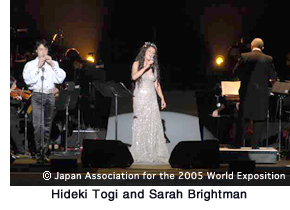 With “Let’s Become Connected through Love The Earth!” as the fundamental concept, there are various events planned at EXPO 2005 Aichi, Japan that will express the theme of this EXPO. “Love The Earth” is a central and symbolic part of such events. “Love The Earth” will deliver a message through the global language of music and inspire people to reconfirm their ties with nature and the Earth.
With “Let’s Become Connected through Love The Earth!” as the fundamental concept, there are various events planned at EXPO 2005 Aichi, Japan that will express the theme of this EXPO. “Love The Earth” is a central and symbolic part of such events. “Love The Earth” will deliver a message through the global language of music and inspire people to reconfirm their ties with nature and the Earth.As part of these events, “Love The Earth Sarah Brightman and her Asian Friends,” a concert in which world-famous soprano vocalist Sarah Brightman of the UK collaborated with three Asian artists, was held on the evening of April 12 at the EXPO 2005 venue. The concert began a little before 7:00pm at the EXPO Dome situated in the Nagakute Area. Sarah Brightman appeared wearing a white, sequin-studded evening dress. She passionately sang her signature piece, “Time to Say Good Bye,” and seven other songs to the accompaniment of the Tokyo Philharmonic Orchestra. When the prelude to a musical composition from the “Phantom of the Opera” - the London musical that elevated Sarah Brightman’s fame in a single spell - began playing, loud applause erupted from fans whose hearts were filled with excitement. Her vocal range of three octaves and her crystalline voice, which has been called the most beautiful in the world, captivated the hearts of the audience. Next, Sarah Brightman introduced Japanese Gagaku (ancient court music) player Hideki Togi; Erhu (Chinese violin) performer, Chen Min; and Guzheng (Chinese stringed instrument) musician Jiang Xiao-Qing; who appeared one by one on stage. Chen Min and Jiang Xiao-Qing together played three musical compositions, including the theme from “The Last Emperor.” Hideki Togi also performed three pieces, which included “New ASIA.” The gentle, beautiful and somewhat nostalgic sound of the classical Chinese instruments - Erhu and Guzheng - deeply penetrated the hearts of the people in the audience. The deep yet clear tone of the traditional Japanese Gagaku wind instruments - Sho (a small mouth organ) and Hichiriki (bamboo oboe) - blended with the timbre of the Western orchestral instruments, yet their distinct resonance created an unearthly world at the concert venue. |
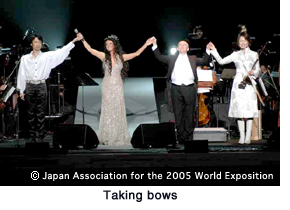 “Scarborough Fair” was performed by all of the artists as the encore piece. Sarah Brightman’s voice and the tones of the three musical instruments became one, and it was met by thunderous applause from the approximately 3,000 people in the audience.
“Scarborough Fair” was performed by all of the artists as the encore piece. Sarah Brightman’s voice and the tones of the three musical instruments became one, and it was met by thunderous applause from the approximately 3,000 people in the audience.The East and West became one on this day and transmitted the “Love The Earth” message to the world. Performances by world-renowned cellist Yo-Yo Ma and other musicians are also scheduled to be held in the future as “Love The Earth” events. |
![]()
 |
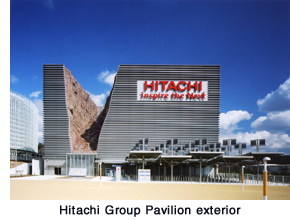 Upon entering Corporate Pavilion Zone B situated close to the North Gate, visitors will immediately notice a pavilion, a part of which looks as if it has been cut away and through which water flows like a waterfall cascading through a gorge. This is the “Nature Contact - Hitachi Group Pavilion's Ubiquitous Entertainment Ride.” The theme of this pavilion is, "Nature Contact - Contact with Endangered Species Revived by Hitachi IT-.”
Upon entering Corporate Pavilion Zone B situated close to the North Gate, visitors will immediately notice a pavilion, a part of which looks as if it has been cut away and through which water flows like a waterfall cascading through a gorge. This is the “Nature Contact - Hitachi Group Pavilion's Ubiquitous Entertainment Ride.” The theme of this pavilion is, "Nature Contact - Contact with Endangered Species Revived by Hitachi IT-.”Ubiquitous technology refers to technology that enables the accessing of images and information services anywhere at anytime. At the Hitachi Group Pavilion, cutting-edge ubiquitous technology - including personal information viewer techniques and image processing information technology - is used to revive images of rare, endangered species, providing visitors with an opportunity to come into contact with rare animals. Another feature of this pavilion is that it offers various services coupled with the 0.4mm-square µ-chip (a microminiaturized IC chip) embedded in all EXPO 2005 admission tickets, giving each ticket a unique ID code. |
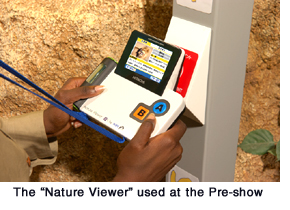 Visitors to the Hitachi Group Pavilion first present their EXPO 2005 admission tickets at the counter and register their names and photos, after which they are handed a Nature Viewer information terminal. The Nature Viewer is a terminal that incorporates state-of-the-art Hitachi Group technology: a fuel cell for mobile devices; “iVDR mini,” which is a compact high-capacity HDD; and a µ-chip reader. Weighing about 600g, the Nature Viewer supports four languages: Japanese, English, Korean and Chinese.
Visitors to the Hitachi Group Pavilion first present their EXPO 2005 admission tickets at the counter and register their names and photos, after which they are handed a Nature Viewer information terminal. The Nature Viewer is a terminal that incorporates state-of-the-art Hitachi Group technology: a fuel cell for mobile devices; “iVDR mini,” which is a compact high-capacity HDD; and a µ-chip reader. Weighing about 600g, the Nature Viewer supports four languages: Japanese, English, Korean and Chinese.Visitors then proceed onto the Pre-show Zone where 42 rare animals - such as the hawksbill turtle and black rhinoceros - which are threatened with global extinction are introduced. By bringing the Nature Viewer, which can be carried around the neck, close to the access point embedded with a µ-chip, the ID for the respective rare animal is read by the information terminal. It enables footage, photos and other data to be replayed anywhere and at anytime. |
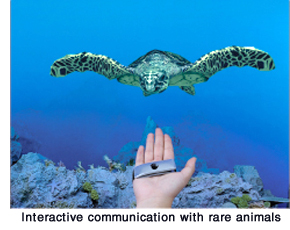 Next is the Main show. It is a 16-passenger ride that journeys through five environment zones, including a jungle, a savanna and an ocean. In each zone, visitors can enjoy interactive communication with rare animals through the latest Mixed Reality (MR) imaging technique. It consists of dioramas that realistically recreate the habitats of rare animals integrated with 3D computer graphics.
Next is the Main show. It is a 16-passenger ride that journeys through five environment zones, including a jungle, a savanna and an ocean. In each zone, visitors can enjoy interactive communication with rare animals through the latest Mixed Reality (MR) imaging technique. It consists of dioramas that realistically recreate the habitats of rare animals integrated with 3D computer graphics.When visitors get on the ride, they look through a binocular-like AdventureScope and wear a sensor on their right hand. The hand sensor is used to enjoy interactive communication with rare animals. As the Ubiquitous Entertainment Ride starts, Dr. Owl, the guide of this show, appears before visitors eyes and surprises people by suddenly calling out the name of each visitor, welcoming them to this journey. In the jungle area, visitors throw a bunch of virtual bananas that they find in their right hand towards some monkeys whereupon the primates approach and pick them up. A huge Orinoco crocodile also suddenly appears, closing upon visitors with its mouth wide open and prompts some people to let out a scream of surprise. In the savanna area, a black rhinoceros angered by the sound of a car horn comes charging toward visitors. In the journey through the ocean, visitors will be able to take their time observing a giant manta and dolphins. They can place a sea turtle that approaches on the palm of their hand and rotate it at will. There will probably be many who will be left with the impression that they want to prevent, by all means, the extinction of such animals. At the end of the journey, visitors will again be surprised when they see, before their eyes, a picture of themselves surrounded by animals. Last at the pavilion is the Post show. By holding up their EXPO 2005 admission ticket to a display, visitors’ names are called out, and they see the photo of themselves that they saw earlier displayed on a screen. This photo can be seen again even after visitors go home. All they need to do is access the Hitachi Group Pavilion website and enter the serial number shown on their EXPO 2005 admission ticket and the date of the pavilion visit. The commemorative photo can be viewed at anytime during EXPO 2005 from the day following the visit to the pavilion. The Hitachi Group Pavilion is a thoroughgoing, highly satisfying pavilion. |
![]()
![]()
 |
|
 The core message of the Canadian Pavilion is what we call the wisdom of diversity in our natural environment and in our culture. Through an exciting multi-media presentation, we express the importance of diversity in our forests, seas and plains. We also show the diversity of the Canadian population by introducing our visitors to six real Canadians of diverse backgrounds and experience.
The core message of the Canadian Pavilion is what we call the wisdom of diversity in our natural environment and in our culture. Through an exciting multi-media presentation, we express the importance of diversity in our forests, seas and plains. We also show the diversity of the Canadian population by introducing our visitors to six real Canadians of diverse backgrounds and experience.One of the things that strikes me as interesting about EXPO 2005 Aichi, Japan is the number of countries that are involved. I think it is very important that the organizers of EXPO 2005 have assisted the developing countries so that they could participate. Another important component is the effective utilization of the Internet and the World Wide Web. Expos need to be as accessible as possible to as many people as possible. The EXPO 2005 Website and the websites of the individual participating countries are important tools to communicate globally. Canada has made a very strong effort to reach its population and the world through its website: www.EXPO2005CANADA.GC.CA. Visitors will also encounter our computer-enhanced guides called “Teku-jin.” The members of our hosting staff wear a computer and an overhead screen showing images of Canada and Canadians. They also wear a Web camera and visitors can have their photo taken and see the results posted on the Canada website. For those not able to visit the pavilion or who want to continue their discovery of Canada, we have made it possible to participate through the Internet. We have created a virtual space that enables Canadians at home or at seven participating museums across Canada and at EXPO 2005 to be connected all the time. Three cyber explorer stations at the pavilion enable visitors to take a virtual tour of Canada. For example, we are inviting school classes to design their own virtual galleries on the theme of diversity. Users from around the world will be able to see these virtual galleries and thereby learn more about Canada and Canadians. We have also created a system that allows these cyber-stations to have live interaction, so we hope that Japanese children will come to our pavilion and take part in meaningful exchanges with the children of Canada. We feel that Expos are the ideal place to display the cultures of the world so that we can learn from each other’s cultures. We love the expression, the “Grand Intercultural Symphony.” We hope that all eyes around the world will be on EXPO 2005 Aichi Japan. |
|
![]()
 Of the many pavilions at EXPO 2005 Aichi, Japan, one of the popular pavilions that are highly regarded by visitors is Japan Pavilion Seto located in the Seto Area.
Of the many pavilions at EXPO 2005 Aichi, Japan, one of the popular pavilions that are highly regarded by visitors is Japan Pavilion Seto located in the Seto Area.Under the theme “The Wisdom, Skills and Spirit of Japanese People Living with Nature - Let’s Recover Our Sensibilities toward Being Connected with Nature,” Japan Pavilion Seto is comprised of three parts. On the first floor is an imagery space where a 7 minute prologue is shown. The second and third floors are a circular theater where the 15 minute “Gundoku” group recitation of an epic poetic drama entitled “One Seed” is performed, and the fourth floor is an art gallery exhibiting works by two artists. Performed live here about a dozen times every day is the Gundoku group recitation of “One Seed,” an epic poetic drama. Gundoku refers to a theatrical production in which actors partake in choral speaking. 66 youths chosen by audition from among more than 2,000 applicants are presenting this group recitation under a double-shift system. Visitors first enjoy, as a prologue to the Gundoku performance, scenes of comfortable life through sound and visual images. Leisurely music is heard as flowers, the sun, a river and snow are projected onto many Washi Japanese paper screens. A shadow-figure-like moon and silver grass then appear, and fireflies dance in the night. The music suddenly becomes up-tempo, and you see innumerable tops that begin spinning. Folding fans of various designs float through the air, and vibrant kimono sashes flow, one after another, like a river. It is a spectacular collection of beautiful Japanese colors. Various sounds of Japan, such as a Japanese drum, wooden clappers, hand drum, and shouts of encouragement, become one with the footage. It is a breathtaking 7 minutes that go by in a flash. |
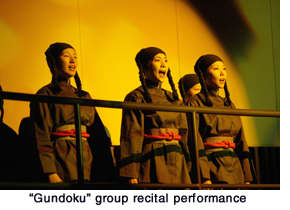 Next, visitors proceed on to the Gundoku performance. The amphitheater on the second floor is packed with an audience of more than 300. The circular stage at the center is surrounded by audience seating, and this seating area, in turn, is surrounded by a corridor which becomes the second stage.
Next, visitors proceed on to the Gundoku performance. The amphitheater on the second floor is packed with an audience of more than 300. The circular stage at the center is surrounded by audience seating, and this seating area, in turn, is surrounded by a corridor which becomes the second stage.The performance begins as the lights are dimmed. A clear female voice resounds in the theater. It is a tone that is remindful of the dynasty of gods. Images of flames and wild waves crashing on rocks are projected on the screens on the wall. These scenes express the birth of all creation. The Shinto prayers of a priestess are heard faintly in the background. A large number of youth rush, with dash and spirit, down the aisle towards the stage. There are more in the corridor behind the audience seating. “Things that do not change,” a man’s voice says. “Things that we must not change,” say all of the men in unison. “Things that can change,” a woman’s voice says. “Things that should change...” say all of the women in unison. The Gundoku group recitation has begun. A myriad of words shower the audience, from the stage at the center and the corridor behind. Passages from nursery rhymes and bits and pieces of children’s songs and nursery tales, all of which every Japanese person has probably heard as a toddler, as well as snippets of festival chants, fill the theater. Youths energetically carry a Mikoshi portable shrine on their shoulders while shouting, “Wasshoi, Wasshoi!” a type of festival chant. In a Japanese version of patty-cake, women, acting out the roles of small girls, face each other and clap their hands together to the rhythm of a cutely sung nursery rhyme. Then, the song “Furusato (hometown)” begins playing quietly. Japanese words and the ring of the words that have been nurtured over a history of over 2,000 years bring out a diverse range of emotions, such as an irresistible sense of nostalgia, the joy of spirited release and even sorrow, among the Japanese audience. To non-Japanese, the Gundoku performance provides an opportunity for them to feel the echo of the Japanese spirit and their delicate emotions; things that go beyond words. A Canadian woman who saw the performance said, after the performance, “It was an exciting show. Even though I don’t understand Japanese, there were things that came across very clearly. I thought it was really wonderful.” There are many repeat guests among the audience of this show. Some say that the face of each performer is becoming more and more beautiful each time that they perform. Perhaps the earnest way in which the actors approach each and every daily performance is enhancing and enriching the spirits of these youths. |
| EXPO 2005 AICHI, JAPAN Newsletter | |
| To read past issues:Back Number | |
| Editor/Publisher: Japan Association for
the 2005 World Exposition Head Office: 1533-1 Ibaragabasama, Nagakute-cho Aichi 480-1101 Japan Nagoya Office: Nagoya Daiya II Bldg 4F, 3-15-1 Meieki Nakamura-ku, Nagoya, Aichi 450-0002 Japan Tokyo Office: Iino Bldg 8F, 2-1-1 Uchisaiwai-cho Chiyoda-ku, Tokyo 100-0011 Japan |
 |
© Japan Association for the 2005 World Exposition
